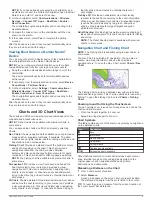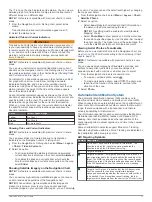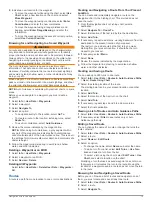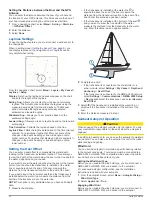
NOTE:
If you have already connected to a chartplotter, and
would like to connect to a different chartplotter, open the Boat
Data screen, hold UP, and select Pair new.
3
On the chartplotter, select
Communications
>
Wireless
Devices
>
Connect IQ™ Apps
>
Boat Data
>
Enable
>
New Connection
.
The chartplotter begins searching for and connecting to the
wearable device.
4
Compare the code shown on the chartplotter with the one
shown on the watch.
5
If the codes match, select
Yes
to complete the pairing
process.
After the devices are paired, they connect automatically when
they are turned on and within range.
Viewing Boat Data on a Garmin Nautix
™
Device
You can connect a Garmin Nautix device to the chartplotter to
view charplotter data on the Garmin Nautix device.
NOTE:
You can connect a Garmin Nautix device to multiple
compatible devices for better coverage on larger vessels.
1
Bring the a Garmin Nautix device within range (3 m) of the
chartplotter.
The device automatically looks for all compatible devices
within range.
2
If necessary, from the wearable device menu, select
Device
Connections
>
Pair New Device
.
3
On the chartplotter, select
Settings
>
Communications
>
Wireless Devices
>
Connect IQ™ Apps
>
Boat Data
>
Enable Connections
>
New Connection
.
The chartplotter begins searching for and connecting to the
wearable device.
After the devices are paired, they connect automatically when
they are turned on and within range.
Charts and 3D Chart Views
The charts and 3D chart views that are available depend on the
map data and accessories used.
NOTE:
3D chart views are available with premium charts, in
some areas.
You can access the charts and 3D chart views by selecting
Charts.
Nav. Chart
: Shows navigation data available on your pre-loaded
maps and from supplemental maps, if available. The data
includes buoys, lights, cables, depth soundings, marinas, and
tide stations in an overhead view.
Fishing Chart
: Provides a detailed view of the bottom contours
and depth soundings on the chart. This chart removes
navigational data from the chart, provides detailed
bathymetric data, and enhances bottom contours for depth
recognition. This chart is best for offshore deep-sea fishing.
NOTE:
The Fishing chart is available with premium charts, in
some areas.
Perspective 3D
: Provides a view from above and behind the
boat (according to your course) and provides a visual
navigation aid. This view is helpful when navigating tricky
shoals, reefs, bridges, or channels, and is beneficial when
trying to identify entry and exit routes in unfamiliar harbors or
anchorages.
3D Chart
: Shows a detailed, three-dimensional view from above
and behind the boat (according to your course) and provides
a visual navigation aid. This view is helpful when navigating
tricky shoals, reefs, bridges, or channels, and when trying to
identify entry and exit routes in unfamiliar harbors or
anchorages.
Fish Eye 3D
: Provides an underwater view that visually
represents the sea floor according to the chart information.
When a sonar transducer is connected, suspended targets
(such as fish) are indicated by red, green, and yellow
spheres. Red indicates the largest targets and green
indicates the smallest.
Relief Shading
: Provides high resolution elevation shading of
lakes and coastal waters. This chart can be helpful for fishing
and diving.
NOTE:
The Relief Shading chart is available with premium
charts, in some areas.
Navigation Chart and Fishing Chart
NOTE:
The Fishing chart is available with premium charts, in
some areas.
The Nav. Chart is optimized for navigation. You can plan a
course, view map information, and use the chart as a
navigational aid. To open the Nav. Chart, select
Charts
>
Nav.
Chart
.
The Fishing Chart provides a detailed view with more bottom
detail and fishing content. This chart is optimized for use when
fishing. To open the Fishing Chart, select
Charts
>
Fishing
Chart
.
Zooming In and Out Using the Touchscreen
You can quickly zoom in and out of many screens, such as the
charts and sonar views.
• Pinch two fingers together to zoom out.
• Spread two fingers apart to zoom in.
Chart Symbols
This table contains some of the common symbols you might see
on the detailed charts.
Icon
Description
Buoy
Information
Marine services
Tide station
Current station
Overhead photo available
Perspective photo available
Other features common to most charts include depth contour
lines, intertidal zones, spot soundings (as depicted on the
original paper chart), navigational aids and symbols,
obstructions, and cable areas.
Measuring a Distance on the Chart
1
From a chart, select a location.
2
Select
Measure
.
A push pin appears on the screen at your present location.
The distance and angle from the pin is listed in the corner.
TIP:
To reset the pin and measure from the current location of
the cursor, select Set Reference.
Charts and 3D Chart Views
9






























